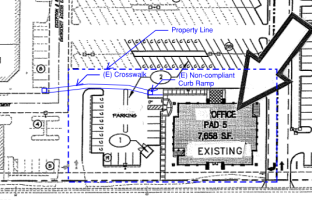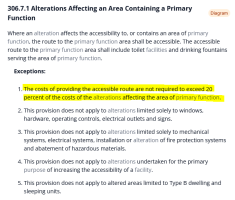I'm working on a project that is in a shopping center. The project is on a separate parcel from the rest of the shopping center but it is only legally separate, not physically. It shares the same parking lot with the larger parcel. Do we still have to comply with 2022 CBC 11B-206.2.2 Accessible Routes Within a Site if they are technically separate parcels?
Currently, there is an existing curb ramp that leads to a path that connects it to other accessible buildings in the shopping center. Unfortunately, whoever built it just made it 6' long without double checking the actual height of the curb. As a result, the curb ramp is steeper than 1:12. We already have to fix the parking spot that has a van sign so that it is actually the size of a van spot and replace the sidewalk to the accessible parking because the cross slope is over 2%. Do we have to upgrade this existing curb ramp too?

Currently, there is an existing curb ramp that leads to a path that connects it to other accessible buildings in the shopping center. Unfortunately, whoever built it just made it 6' long without double checking the actual height of the curb. As a result, the curb ramp is steeper than 1:12. We already have to fix the parking spot that has a van sign so that it is actually the size of a van spot and replace the sidewalk to the accessible parking because the cross slope is over 2%. Do we have to upgrade this existing curb ramp too?




